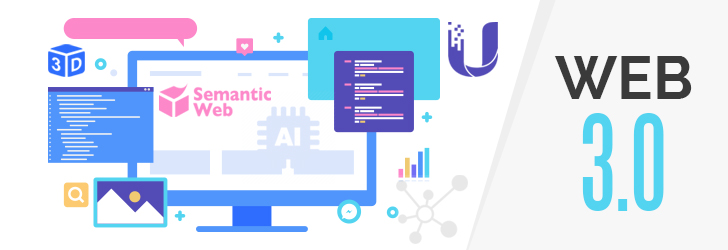
The web has undergone significant transformations since its inception, evolving from Web 1.0, the most rudimentary form of the internet, to Web 2.0, which introduced interactivity and dynamic web pages.
To briefly outline its history, Web 1.0 consisted of static web pages that served purely informational purposes. This evolved into Web 2.0, which brought social networking, Ajax, media sharing, and real-time collaboration, making the web more engaging and interactive.
However, the evolution of the internet doesn’t stop there. The next major leap is Web 3.0, a more intelligent, data-driven web that is currently in development.
What is Web 3.0?
Web 3.0, often referred to as the third generation of the web, aims to be more intelligent, decentralized, and self-sufficient. Unlike Web 2.0, which primarily focuses on user-generated content and interactivity, Web 3.0 incorporates advanced technologies such as artificial intelligence (AI), blockchain, semantic web, and edge computing.
There is no universally accepted definition of Web 3.0, but its primary objective is to create a web that can process and interpret information in a more human-like manner, offering a seamless and more personalized user experience.
How Will Web 3.0 Work?
Understanding Web 3.0 can be challenging without concrete examples. Let’s explore how it will enhance web searches.
Currently, search engines rely on keyword-based searches. For example, if you type "horror movie and mobile phone shopping," the search engine provides results based on exact keyword matches.
However, with Web 3.0, search engines will evolve beyond simple keyword matching. They will use AI and user behavior analysis to deliver personalized results. If a user types "I want to watch a horror movie and buy a mobile phone," the search engine will analyze past browsing behavior and preferences to provide customized recommendations.
Additionally, Web 3.0 will enable search engines to distinguish between different meanings of the same word based on user intent. For example, if you search for "cricket," the search engine will determine whether you mean the sport or the insect based on your previous interactions.
Unlike Web 2.0, where search results are mostly uniform for all users, Web 3.0 will deliver contextual and personalized search results tailored to each individual user.
Main Features of Web 3.0
1. Artificial Intelligence
Web 3.0 will integrate AI and natural language processing (NLP) to help computers understand human language and provide more relevant search results. This will lead to faster, more precise information retrieval.
2. Semantic Web
Unlike traditional keyword-based searches, the semantic web will focus on understanding the meaning behind words. This will allow search engines to provide results based on context rather than just keyword matches.
3. Connectivity
Web 3.0 will enhance interconnectivity, making information more accessible across various platforms and devices. This will improve user experience and usability.
4. 3D Graphics
With the rise of virtual reality (VR) and augmented reality (AR), Web 3.0 will incorporate 3D graphics in websites, applications, and online services, revolutionizing industries such as gaming, e-commerce, and education.
5. Ubiquity
Web 3.0 will ensure that the same content and services are accessible from multiple devices and applications. This means that data and services will be available anywhere, anytime, across all devices.
Popular examples of early Web 3.0 implementations include Apple's Siri and Amazon's Alexa, which use AI and voice recognition to interact with users intelligently.
Challenges in Web 3.0 Development
Although Web 3.0 has tremendous potential, it faces several challenges that need to be addressed:
1. Lack of Skilled Professionals
Developing Web 3.0 applications requires expertise in AI, blockchain, big data, and decentralized computing. However, the current workforce lacks sufficient knowledge in these areas, making innovation difficult.
2. Data Storage and Scalability
Web 3.0 will generate enormous amounts of data. Storing, managing, and securing this data requires efficient cloud computing, big data analytics, and decentralized storage solutions.
3. Privacy and Security Concerns
As Web 3.0 integrates AI and collects vast amounts of user data, privacy laws and regulations must be established to ensure responsible data usage. Countries worldwide are debating how much access Web 3.0 platforms should have to personal data.
4. Search Engine Optimization (SEO) Challenges
Traditional SEO relies on keywords and backlinks to rank web pages. However, with Web 3.0’s AI-driven algorithms, these methods may become obsolete. The future of SEO in a decentralized web remains uncertain.
5. Compatibility with Existing Technologies
Many existing web applications may not be compatible with Web 3.0, requiring significant updates or even complete overhauls. This also raises the question of whether current web browsers will need to be updated to support Web 3.0 functionalities.
Conclusion
Web 3.0 represents the next major evolution of the internet, promising a more intelligent, connected, and decentralized web. With AI, blockchain, and semantic web technologies at its core, Web 3.0 aims to provide a seamless, personalized, and more efficient digital experience.
However, the transition to Web 3.0 is still in progress. While the benefits are immense, challenges related to privacy, scalability, workforce expertise, and technological adoption need to be addressed before it becomes a mainstream reality.
Despite these challenges, Web 3.0 has the potential to redefine how we interact with the digital world, making it more intuitive, secure, and efficient. As research and development continue, we can expect groundbreaking innovations that will shape the future of the internet.
Share this post
Leave a comment
All comments are moderated. Spammy and bot submitted comments are deleted. Please submit the comments that are helpful to others, and we'll approve your comments. A comment that includes outbound link will only be approved if the content is relevant to the topic, and has some value to our readers.

Comments (0)
No comment